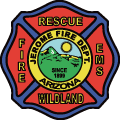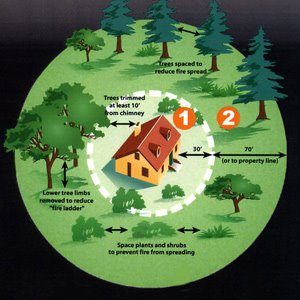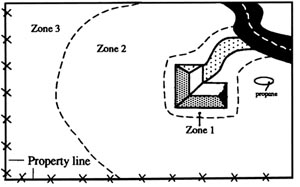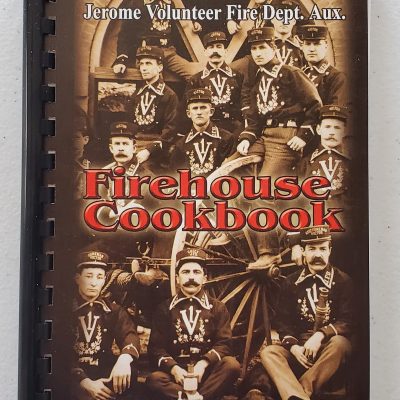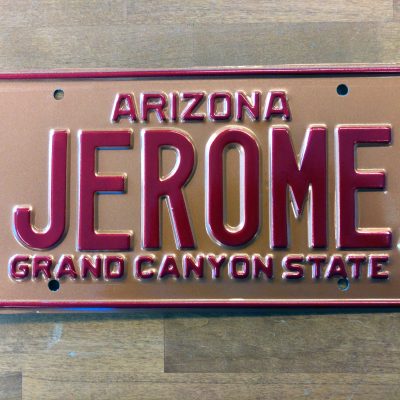Fire Is Unpredictable
Fire can find the weak link in your home’s fire protection scheme and gain the upper hand because of a small, overlooked or seemingly inconsequential factor. While you may not be able to accomplish all measures below, each will increase your home’s, and possibly your family’s, safety. Start with the easiest and least expensive actions. Begin your work closest to your house and move outward. Keep working on the more difficult items until you have completed your entire project. Jerome is unique as many homes are very close together. Work with your neighbors and friends to make your neighborhood safer.
Defensible Space
Defensible space is an area around a structure where fuels and vegetation are treated, cleared or reduced to slow the spread of wildfire towards the structure. It also reduces the chance of a structure fire moving from the building to the surrounding forest. Defensible space provides room for firefighters to do their jobs. Your house is more likely to withstand a wildfire if grasses, brush, trees and other common forest fuels are managed to reduce a fire’s intensity.
Two factors have emerged as the primary determinants of a home’s ability to survive wildfire. These are the home’s roofing material and the quality of the “defensible space” surrounding it.
Use Uniform Building Code Class C or better rating fire-resistive materials, not wood or shake shingles, to roof homes in our area. When your roof needs repair or replacement, do so with a fire-resistant roofing material. Check with the Town of Jerome building department.
Creating defensible space involves developing a series of management zones in which different treatments are used. See Figure 1 for a general view of the relationships among these management zones. Develop defensible space around each building on your property. Include detached garages, storage buildings, barns and other structures in your plan.
The design of your defensible space depends on several factors: size and shape of buildings, materials used in their construction, the slope of the ground on which the structures are built, surrounding topography, and sizes and types of vegetation on your property.
Defensible Space Management Zones
Zone 1 is the area of maximum modification and treatment. It consists of an area of 15 feet around the structure in which all flammable vegetation is removed. The15 feet is measured from the outside edge of the home’s eaves and any attached structures, such as decks. The distance should be increased to 30 feet if you live in a chapparral or paradise tree vegetation type; which Jerome has an abundance of untreated areas.
Zone 2 is an area of fuel reduction. The size of Zone 2 depends on the slope of the ground where the structure is
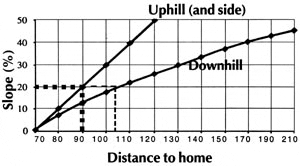
This chart indicates the minimum dimensions for defensible space from the home to the outer edge of Zone 2. For example, if your home is situated on a 20 percent slope, the minimum defensible space dimensions would be 90 feet uphill and to the sides of the home and 104 feet downhill from the home.
built. Typically, the defensible space should extend at least 75 to 125 feet from the structure. See Figure 2 for the appropriate distance for your home’s defensible space. Within this zone, the continuity and arrangement of vegetation is modified. Remove stressed, diseased, dead or dying trees and shrubs. Thin and prune the remaining larger trees and shrubs. Be sure to extend thinning along either side of your driveway all the way to your main access road. These actions help eliminate the continuous fuel surrounding a structure while enhancing home site safety and the aesthetics of the property.
Zone 3 is an area of traditional native vegetation management and is of no particular size. It extends from the edge of your defensible space to your property boundaries.
Prescriptions
Zone 1
The size of Zone 1 is 15 feet, measured from the edges of the structure. Within this zone, several specific treatments are recommended.
Plant nothing within 3 to 5 feet of the structure, particularly if the building is sided with wood, logs or other flammable materials. Decorative rock creates an attractive, easily maintained, nonflammable ground cover.
If the house has noncombustible siding, widely spaced foundation plantings of low growing shrubs or other “fire wise” plants are acceptable. Do not plant directly beneath windows or next to foundation vents. Be sure there are no areas of continuous grass adjacent to plantings in this area.
Frequently prune and maintain plants in this zone to ensure vigorous growth and a low growth habit. Remove dead branches, stems and leaves. Contact the Jerome Fire Department to gain access to our burn pile.
Do not store firewood or other combustible materials in this area. Enclose or screen decks with metal screening. Extend the gravel coverage under the decks. Do not use areas under decks for storage.
Ideally, remove all trees from Zone 1 to reduce fire hazards. If you do keep a tree, considered it part of the structure and extend the distance of the entire defensible space accordingly. Isolate the tree from any other surrounding trees. Prune it to at least 10 feet above the ground. Remove any branches that touch or interfere with the roof or are within 10 feet of the chimney. Remove all “ladder fuels” from beneath the tree. Ladder fuels are small shrubs, trees, tree limbs and other materials that allow fire to climb into the tree crown — the branches and foliage.
Zone 2
Zone 2 is an area of fuel reduction designed to reduce the intensity of any fire approaching your home. Follow these recommended actions in this zone.
Thin trees and large shrubs so there is at least 10 feet between crowns. Crown separation is measured from the furthest branch of one tree to the nearest branch on the next tree (Figure 3). On steep slopes, allow more space between tree crowns. Remove all ladder fuels from under these remaining trees. Carefully prune trees to a height of 10 feet.
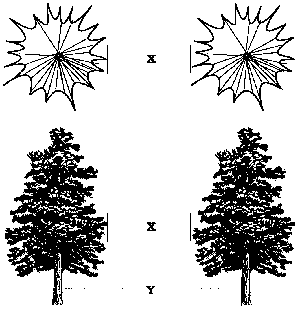
Figure 3: X = crown spacing; Y = stem spacing. Do not measure between stems for crown — measure between the edges of tree crowns.
Because Zone 2 forms an aesthetic buffer and provides a transition between zones, it is necessary to blend the requirements for Zones 1 and 3. Thin the inner portions of Zone 2 more heavily than the outer portions. Gradually increase tree density as you approach Zone 3.
Isolated shrubs may remain, provided they are not under tree crowns. Prune and maintain these plants periodically to maintain vigorous growth. Remove dead stems from trees and shrubs annually.
Mow grasses or remove them with a weed trimmer as needed through the growing season to keep them low, a maximum of 6 to 8 inches. This is extremely critical in the fall when grasses dry out and cure or in the spring after the snow is gone but before the plants green up.
Stack firewood and woodpiles uphill or on the same elevation as the structure but at least 30 feet away. Clear and keep away flammable vegetation within 10 feet of these woodpiles. Never stack wood against your house or on or under your deck, even in winter. Many homes have burned from a woodpile that ignited as the fire passed. Wildfires can burn at almost any time in Arizona.
Locate propane tanks at least 30 feet from any structures, preferably on the same elevation as the house. You don’t want the propane tank below your house — if it ignites, the fire would tend to burn uphill. On the other hand, if the tank is above your house and it develops a leak, propane gas will flow downhill into your home. Clear and keep away flammable vegetation within 10 feet of these tanks. Do not screen propane tanks with shrubs or vegetation.
Dispose of slash (limbs, branches and other woody debris) removed from your trees and shrubs through chipping or by piling and burning. Contact the Jerome Fire Department for information about burning slash piles.
Zone 3
Zone 3 is of no specified size. It extends from the edge of your defensible space to your property lines. In this area, you are encouraged to manage your forests in a more traditional manner. Typical management objectives for areas surrounding home sites or subdivisions are: recreational use; aesthetics; maintain tree health and vigor; barriers for wind, noise, dust and visual intrusions; limited production of firewood, fence posts and other forest commodities; or growing Christmas trees or trees for transplanting.
Specific thinning requirements will be dictated by your objectives for your land. Thinning improves the native vegetation by removing trees that are damaged, attacked by insects or are infected by disease. A greater number of wildlife trees can remain in Zone 3. Make sure dead trees pose no threat to power lines or fire access roads.
Maintaining Your Defensible Space
Defensible Space Annual Checklist
- Trees and shrubs are properly thinned and pruned within the defensible space. Slash from the thinning is disposed of.
- Roof and gutters are clear of leaves, needles, and other debris.
- Branches overhanging the roof and chimney are removed.
- Chimney screens are in place and in good condition.
- Grass and weeds are mowed to a low height.
- An outdoor water supply is available, complete with a hose and nozzle that can reach all parts of the house.
- Fire extinguishers are checked and in working condition.
- The driveway is wide enough. The clearance of trees and branches is adequate for fire and emergency equipment.
- Road signs and your house number are posted and easily visible.
- There is an easily accessible tool storage area with rakes, hoes, axes and shovels for use in case of fire.
- You have practiced family fire drills and your fire evacuation plan.
- Your escape routes, meeting points and other details are known and understood by all family members.
- Attic, roof, eaves and foundation vents are screened and in good condition. Foundations and decks are enclosed, screened or walled up.
- Trash and debris accumulations are removed from the defensible space.
